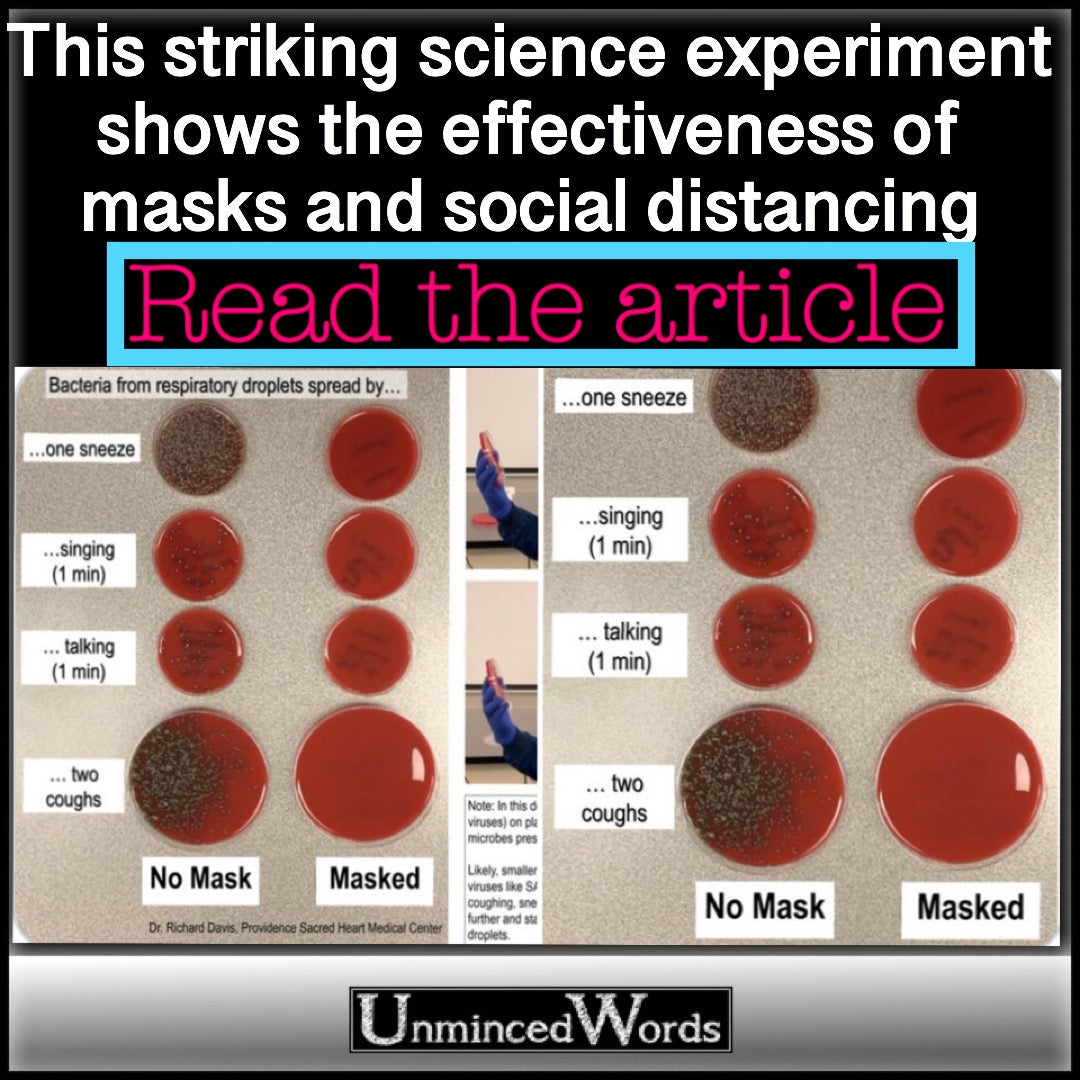
This striking science experiment shows the effectiveness of masks and social distancing
This striking science experiment shows the effectiveness of masks and social distancing
Through coughing, sneezing, and belting out a ‘Hamilton’ tune, a microbiologist showed how droplets travel far less when people wear masks.
If anyone heard a Hamilton show tune emanating from the lab at Providence Sacred Heart Medical Center in Spokane, Washington, that was likely from a test being conducted on the effectiveness of face masks in blocking flying respiratory droplets.
Rich Davis, microbiology director for the Sacred Heart Laboratory, published a visual demonstration on Twitter that vividly shows how masks and social distancing help contain the spreading of “big, fat, wet respiratory droplets,” and potentially of SARS-CoV-2 (the virus causing COVID-19), which is known to spread via those globules.
Davis performed four everyday actions, all of which are “opportunities for large droplets of spit and stuff from your respiratory tract to get out into the environment.” He coughed, sneezed, talked, and sang at identical culture plates, firing bacteria from his mouth onto the agar jelly, to create a visual representation of the number of bacteria droplets that can reach another human being when the spit producer is masked or unmasked.
These are harmless bacteria that he says “live happily, secretly in your mouth, your nose, your throat.” The coronavirus is, of course, caused by a virus, not bacteria. But the same concept applies to the coronavirus, which we know is spread primarily through inhaling or touching those beads of saliva.
The results were as expected, and in line with CDC guidelines: The masked test didn’t produce any visible droplets on the agar in any of the instances, while the unmasked tests produced voluminous quantities of droplets. Most, by far, came from sneezing, followed by coughing, then talking and singing, which generated about the same amount of spittle.
In a separate social distancing test, he coughed for 15 seconds at two, four, and six feet from the dishes. At each stage, fewer and fewer droplets landed on the jelly; at six feet, the recommended range for social distancing, there was just one visible droplet from an unmasked hack.
The test started as a simple response to an internal request within the regional chain of hospitals that asked someone to demonstrate the value of wearing face masks. So, on a weekend, Davis headed to the lab and set up the apparatus in less than an hour, his phone propped up on test tube racks. But “it’s snowballed” and has gone coronaviral on Twitter.
Davis is fully aware of the limitations of his experiment—in fact, he doesn’t call it an experiment, rather a demonstration, because he’s the only data point, and he knew the outcome going in. It can’t account for what others would produce—”would their cough be as wet?”—although his second data point, local reporter Kevin Kim, produced similar results.
Davis also answered the most pressing questions on an extensive Twitter thread, including admitting he had to fake a sneeze because the age-old pepper-induced sneeze only served to make his eyes watery.
And he said that, for the singing test, he gave a rendition of “Dear Theodosia” from the musical Hamilton. (Kim, the reporter, belted out Tupac’s “Changes” and Smashmouth’s “All Star”; the Tupac track produced more droplets.) While singing may seem like a niche concern, a choir rehearsal in Washington State in March was one of the first known “super-spreader” events, infecting 52 people.
Increasing the volume or length of talking or singing would likely increase the number of droplets, meaning it’s easy to see how other fevered events could become super-spreaders.
The point of the demo, Davis stresses, is not to criticize people who haven’t been following best practices; they might have bad information or just been pushed by politicization. “Shame is a really bad practice for helping encourage good public health decisions,” he says. Instead, officials need to make more masks available and normalize their use.
One thing Davis didn’t foresee was generating some of the more visceral reactions on social media, where people have expressed revulsion at the resident bacteria in their systems. (“This is disgusting, my mouth is disgusting, I am disgusting,” he summarizes.) “I’m a little inured to bacteria in your mouth,” he says, “[because] I am a microbiologist.”
REPOST REPOST #wearamask #mask #germs #science #athome #unminced #health #life #chemistry #covidnews #covid



















